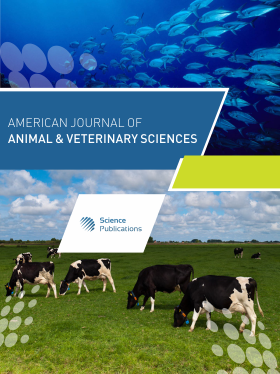Stressors Influence on Salmonella enterica Serovar Enteritidis Colonization in Broilers
- 1 Tuskegee University, United States
- 2 Suez Canal University, Egypt
Abstract
Problem statement: Poultry industry usually exposing birds to a variety of actions and stressors includs fasting for gastrointestinal emptying before transportation and where birds are often exposed to high environmental temperature during the summer months. These environmental stressors may have influences on bird performance and susceptibility to pathogens such as Salmonella enteritidis by altering the intestinal micrbiota and changes in the gut integrity. Approach: This research was conducted to show that acute stressors in the poultry production can induce changes in the normal intestinal microbiota and epithelium structure and execratory functions, which may cause an increase in the opportunities of attachment of Salmonella enteritidis. Results: Experiments were conducted to determine the influence of 24 h feed withdrawal with 24 h exposure to high temperature (30°C) on intestinal characteristics of broilers. Attachment of Salmonella enteritidis to ileal tissue was determined using an in vitro ileal loop assay. Changes in commensally intestinal microbial populations were determined using gel electrophoresis and alterations in ileal morphology were determined histologically. The results showed that attachment of Salmonella enteritidis to ileal tissues increased by 1.5 logs (9.05 log10 Vs 7.59 log10 Salmonella enteritidis/g of ileal tissue; p = 0.0006) in broilers fasted for 24 h also, ileal tissues from birds subjected to 30°C for 24 h had increased the attachment of Salmonella enteritidis (8.77 log10 Vs 8.50 log10 Salmonella enteritidis/g of ileum; p = 0.01) compared with birds held at 23°C. Exposure to 30°C for 24 h also altered the microbial structure in the ileum and cecum. Where subjecting birds to 30°C for 24 h reduced the crypt depth (6.0 Vs 7.8 µm, respectively; p = 0.002), but it had no effect on villus height or villus: Crypt ratio. Conclusion: The findings of the experiment explained the mechanisms by which stressors alters the normal intestinal characterization and induces susceptibility to enteric infection. Future work should focus on the use of prophylactic measures to reduce the stress conditions causing alteration of the intestinal microbiota and changes in gut integrity like considering the probiotic organisms the offer a promising solution for reducing pathogen colonization when fed orally.
DOI: https://doi.org/10.3844/ajavsp.2009.42.48

- 3,907 Views
- 4,363 Downloads
- 9 Citations
Download
Keywords
- Salmonella enteritidis
- heat stress
- microbial
- colonization
- broilers
